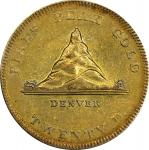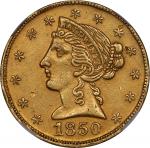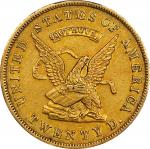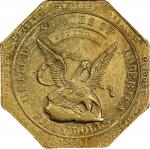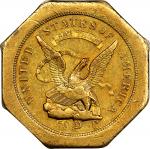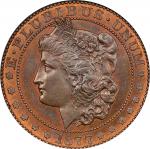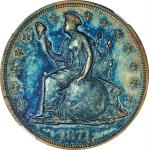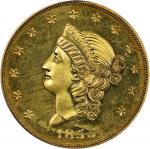1855 Kellogg & Co. $50. K-4. Rarity-7-. Proof-63 Cameo (PCGS). CMQ-X.A famous example of one of the rarest and most coveted of all private California Gold Rush issues, and a beautiful Choice Proof specimen. Vivid golden-yellow surfaces also reveal subtle olive undertones as the coin rotates under a light. Detail on both sides is razor sharp to full to allow ready appreciation of this iconic design. The definition is far superior to what one would expect to see in a circulation strike gold coin produced under the rustic conditions prevailing in California at the height of the Gold Rush - obviously the utmost care was used in creation of this special coin. Some hairlines are present in the fields, perhaps as expected at the certified Proof-63 Cameo level, and as seen on all surviving specimens. There are no significant marks, however, and a small planchet rift (as made) that extends from Libertys neck through the final digit 5 in the date to the border is the most useful identifier for provenance purposes.
The 1855 Kellogg & Co. $50 is one of the great high points among private California Gold Rush coins and has a fame reached by few other pieces in the series. In his reference work on the subject, Don Kagin noted: "This is one of the most popular private gold pieces and is called the King of Territorial Gold, as it is considered to be one of the most beautiful of the private gold series."
The obverse depicts a female portrait adapted from the head of Liberty as seen on the United States Mints contemporary $20 double eagle gold coin, but with the coronet inscribed KELLOGG & Co. Thirteen stars around the periphery were punched into the die using six diamond-shaped elements individually punched, with the Proof field visible (and at the same plane as the field) between the pellet elements; each star is somewhat differently formed. The date 1855 is at the bottom. The reverse has an elegantly engraved perched eagle in the style of Charles Cushing Wrights 1851 Humbert coinage produced by the United States Assay Office in San Francisco, but slightly differently executed, and with the ribbon inscribed 1809 GRS / 887 THOUS. Around the border on this side of the coin appears the legend SAN FRANCISCO CALIFORNIA above and the denomination FIFTY DOLLS. below. The dies were executed by Ferdinand Grüner, whose signature F. GRÜNER appears on the neck truncation.
In his study <em>Private Gold Coinage of California 1849-1855 </em>published in 1912, Edgar H. Adams (p. 87) noted that Grüner was "a well-known die cutter of San Francisco." Further, "This represents one of the handsomest pieces of die-cutting in the entire California series." If Adams knew more, he did not relate it in his text. Moreover, virtually nothing concerning the biography of Grüner has appeared elsewhere in numismatic circles. He is not listed in Leonard Forrers incomparable <em>Biographical Dictionary of Medalists</em>, nor is he treated except in passing by Don Kagin, Richard D. Kenney, Walter Breen, and others who have focused upon California diecutters. Indeed, Kenney discussed diecutting at Kellogg & Co. without even mentioning Grüner.
Obverse from perfect die state. The reverse, however, exhibits a delicate tracery of die breaks, not normally described. These include from rim through left side of the letter O in OF to ribbon held by eagle, extending downward and branching from the left side of the eagles neck to the wing to the left, through the base of the wing to the ribbon and left side of shield, then in the field to close to the letter S in SAN. Another crack connects the letter O in SAN FRANCISCO with the C to its right, continuing through the bases of the letters in CALIFORNIA, then irregularly through the letters in DOLLS, then through the tops of the letters in FIFTY. The same cracks are seen on the special restrikes from these dies made in 2001 using gold recovered from the <em>S.S. Central America </em>treasure for presentation to the principals of the California Gold Marketing Group, an example of which is offered in the following lot.
The production of $50 gold "slugs" of the round format by the firm of Kellogg & Co. traces its inception to a demand for such in commerce in California. The <em>San Francisco Herald</em>, March 1, 1854, noted:
<em>A petition has been circulated today, and very generally signed, addressed to the Congress of the United States, calling attention to the coinage that is to be made at the Branch Mint in San Francisco and praying that a law may be passed authorizing the issue of Fifty Dollar pieces of the same shape and fineness as the United States Double Eagle. It will of course be signed by every business man in the community, the advantages of such an issue being self-evident. In a country like our own, where the currency is purely metallic, it is of great importance to have coins issued of a size which will admit of rapid and easy counting, both in receiving and paying money; and the experience of all our businessmen goes to show that in the absence of bank notes the Fifty Dollar piece is the most convenient coin for such a purpose. The alteration in the shape [from the octagonal $50 then in common use], and putting it up to the United States standard [900 fine instead of the 880, 884, and 887 finenesses used earlier], would make it all that could be desired. If such a coin should be issued, it would in all probability speedily reduce the premium on ounces for East India shipments.</em>
James Guthrie, secretary of the Treasury, responded with his opinion on March 21, 1854, noting that even $20 gold pieces did not circulate actively in the East, "but are soon passed into the possession of the banks and bankers, and their places supplied by bank paper." This being the case, even larger $50 pieces would be of little use there. However, there was no paper money in circulation in California, and, "the high scale of prices prevalent in California for commodities and service.will make larger denominations of coin convenient, particularly in counting and passing large sums."
Guthrie recommended that $100, $50, and $25 gold coins be authorized for coinage at the San Francisco Mint and be called the Union, Half Union, and Quarter Union, "but that the Half Union only be struck for the present."
Although Guthries suggestion and subsequent legislation by Senator William M. Gwin received favorable notice, and the Senate passed Gwins bill by a large majority, the proposal died in the House of Representatives. In this void Wass, Molitor & Co. issued round $50 coins in 1855 to fill the demand. Survivors of that issue, attributed in todays numismatic community as Kagin-9, are very scarce, eagerly sought by advanced collectors, and are greeted with considerable excitement whenever an example appears at auction. Stacks Bowers Galleries sold an example certified AU-50 by PCGS for $114,000 as lot 2387 in our March 2018 Baltimore Auction.
Meanwhile, Kellogg & Co., the partnership of John Glover Kellogg and Augustus Humbert, produced some 300,000 $20 gold pieces in 1854 and 1855. The firms coining activities filled a critical void in the commerce of Gold Rush California since it came between the dissolution of the United States Assay Office of Gold in 1853 and the delivery of the first double eagles from the San Francisco Mint. Even though the federal Mint placed its first double eagles into circulation in 1854, and operations continued apace through 1855 and beyond, the Kellogg & Co. pieces of both years were eagerly sought by local businesses. On the other hand, once San Francisco Mint gold coinage became firmly established in commercial channels, many of their privately produced predecessors were withdrawn from circulation and melted for their bullion content. Kellogg & Co. continued in operation until 1860, with Kellogg and Humbert still in partnership, but issued no coins after 1855.
While the firms $20 coins have been well known from the time of issue, its round $50 coins of 1855 remain enigmatic to this day. Their origin is shrouded in mystery, so far as is known none were either produced for or released into circulation, and numismatic knowledge of the issue was limited throughout the 19th century. Adams (1912) noted:
<em>Although the California newspapers in 1855 mention the Fifty Dollar piece of Wass, Molitor & Co., yet they do not contain the slightest reference to that of Kellogg & Co. (that could be found), which would seem to indicate that the coinage of that denomination did not go beyond the experimental stage, and that the thirteen known pieces now located were scarcely more than trial pieces.</em>
Inasmuch as the known specimens are struck in Proof format, it has become generally accepted among numismatic scholars that these special Kellogg & Co $50s were intended as presentation pieces to illustrate the firms desire and ability to place a coin of this denomination into circulation as a competitor to Wass, Molitor & Co.s round $50. It seems, however, that Kellogg & Co. abandoned this venture almost immediately and issued no circulation strike coins of this denomination.
In addition to advertising the firms capabilities, these Proofs would certainly have lent support to those arguing for production of round $50 gold coins at the newly opened San Francisco Mint. Whether presentation to influential politicians and businessmen was originally intended can only be conjectured, but upon striking most, if not all specimens were retained by the principals of the firm. Three of these were still in possession of John Glover Kelloggs heirs many years after his death in 1886, and Augustus Humbert had at least six at the time of his death in 1873. Kellogg, Humbert and/or their heirs may have distributed a few to personal acquaintances or other interested parties during the later decades of the 19th century. Most eventually found their way into numismatic hands.
In the absence of records we can only guess as to how many Proof $50s were struck by Kellogg & Co. in 1855. The number of coins extant provides the best clue since, as Proofs that were not intended for commercial use, few, if any would have succumbed to attrition, although some are impaired from mishandling. Yet even the exact number of survivors has been debated by numismatists, with estimates ranging from seven to nine on the low side to an overly aggressive total of 16 known on the other end of the spectrum. The census of 13 coins compiled by DeWitt S. Smith and published in Adams (1912, p. 86) proved the most accurate and stood the test of time until an additional specimen emerged from an East Coast estate and was offered in Heritages ANA Platinum Night Auction of August 2010, bringing the current census to 14. The most up-to-date and comprehensive roster, including accurate provenances for the individual specimens, was published in Heritages April 2014 CSNS Signature Auction and expands on previous listings with contributions from numismatic researchers P. Scott Rubin, Karl Moulton, Don Kagin, and others.
The Eliasberg specimen offered here is one of at least six Proof Kellogg & Co. $50s that were still in Augustus Humberts possession at the time of his death in 1873. Its earliest numismatic provenance includes such well-known names as Captain Andrew C. Zabriskie, Henry Chapman, John Story Jenks and Arthur C. Nygren. Featured in the Eliasberg Collection booklet, "An Exhibition of the Worlds Foremost Collection of United States Coins," Louis E. Eliasberg, Sr. regarded this 1855 Kellogg & Co. $50 as one of the most important and historical of his private gold coin issues - a sentiment that will surely be echoed by its next owner.
This lot includes a custom large blue Capital Plastics holder created for this coin as part of the Eliasberg Collection. <em><strong>The holder is available to the winning bidder upon request to Stacks Bowers Galleries at the close of the auction</strong></em>.PCGS# 804507. NGC ID: ANJ3.From the Louis E. Eliasberg, Sr. Collection. Earlier ex Augustus Humbert, retained until his death in 1873; Humberts heirs; Capt. Andrew C. Zabriskie; Henry Chapman; John Story Jenks; Reuting Collection; Henry Chapmans sale of the Arthur C. Nygren Collection, April 1924, lot 82; Henry Chapman (per B. Max Mehl in the Waltman catalog); Thomas L. Elders sale of the Dr. George Alfred Lawrence Collection, June 1929, lot 1365; John H. Clapp; Clapp estate, 1942; Louis E. Eliasberg, Sr.; Eliasberg estate; our (Bowers and Merenas) sale of the Louis E. Eliasberg, Sr. Collection, May 1996, lot 366.



